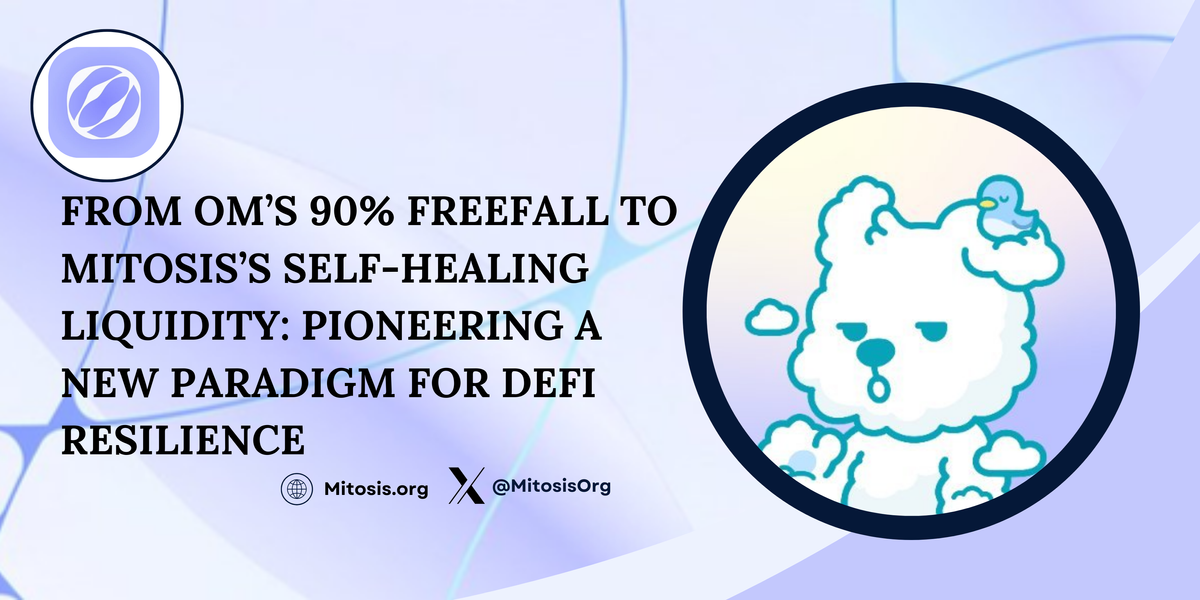From OM’s 90% Freefall to Mitosis’s Self-Healing Liquidity: Pioneering a New Paradigm for DeFi Resilience

Mantra’s crash on April 13, 2025, was a perfect storm of factors: over-inflated token emissions, concentrated leverage, and thin order books on key exchanges led to cascading liquidations that wiped out more than 90% of OM’s value in just a few hours. Ironically, during this chaos, its Total Value Locked (TVL) shot up by 500%, which only masked the underlying illiquidity and fueled panic as the decline began. On the flip side, Mitosis has built its foundation on protocol-owned liquidity vaults instead of relying on mercenary liquidity providers. It utilizes tokenized, cross-chain capital that’s algorithmically rebalanced, along with on-chain governance safety measures, creating a self-healing framework. Even if Mitosis encounters a market shock, its programmable liquidity model, emergency-pause features, and gradual emission schedules are designed to mathematically limit losses and ensure a swift recovery.
The Rise—and Sudden Plunge—of OM
- Monumental Partnerships and All-Time Highs
In January 2025, Mantra made waves by announcing a groundbreaking US $1 billion partnership with Dubai’s DAMAC Group to tokenize real-world property assets—an unprecedented collaboration that sent confidence soaring. Just a month later, on February 19, Mantra became the first DeFi protocol to secure a VARA license, further solidifying its legitimacy in the eyes of investors. Thanks to these exciting developments, OM skyrocketed from below $0.03 in 2024 to an impressive all-time high of $8.99 on February 22—a staggering increase of over 300 times in just about six months. See https://www.coindesk.com/business/2025/01/09/mantra-blockchain-to-tokenize-1-b-of-real-world-assets-for-uae-based-property-firm-damac? - Incentives That Inflated—and Imploded—Value
Mantra’s tokenomics were heavily reliant on generous staking and farming rewards, which led to the minting of new OM tokens at a pace that outstripped organic demand. When early investors’ vesting cliffs unlocked large amounts of tokens, it created a wave of selling pressure as soon as prices stabilized. At the same time, the surge in derivatives trading—up 7,000% on the day of the crash—meant that liquidations cascaded through the thin order books of major exchanges like Binance and OKX, triggering a devastating sell-off. See https://cryptoslate.com/om-token-crashes-over-90-mantra-blames-centralized-exchanges/?
Anatomy of the April 13 Flash Crash
- A 90% Freefall in Hours
On April 13, OM took a nosedive from around $6.30 to under $0.50—an astonishing drop of over 90%—in just a few trading sessions. This prompted some centralized exchanges to hit the brakes on trading to curb the chaos. The market cap plummeted from about $6 billion to roughly $530 million, wiping out more than $5 billion in value overnight. See https://finance.yahoo.com/news/mantra-token-plunges-90-227-011813367.html?
- The TVL Paradox and Liquidity Mirage
Paradoxically, Mantra’s TVL on its RWA staking rails jumped by 500 % to 4.2 million OM (~$3.2 million) even as the price collapsed, signaling that TVL alone can mask token illiquidity. DeFiLlama data show a >50 % TVL drawdown over the ensuing week, as panic withdrawals drained what little depth remained
Mathematical Breakdown: Why OM Tanked
Emission Rate vs. Demand: If Mantra minted, say, 50 million OM/month for rewards into a market averaging 20 million traded per month, that’s a 250 % Anatomy of the April 13 Flash Crash
- A 90 % Freefall in Hours
On April 13, OM plunged from roughly $6.30 to below $0.50—over a 90 % loss—within a few trading sessions before some centralized venues suspended trading to stem volatility. The market cap imploded from ~$6 bi—unsustainable once yields faded. - Liquidation Cascade: A single margin call of $100 million on 10× leverage necessitates $10 million of immediate sell orders. With only $5 million in depth at that price band, price gaps widen, forcing further liquidations—a positive feedback loop.
These dynamics illustrate how thin order books + high leverage + misaligned emissions can mathematically guarantee a crash. Let us now look at why Mitosis's ecosystem is more resilient to such a crash.
Why Mitosis’s Design Is Inherently More Resilient
- Protocol-Owned, Tokenized Liquidity Vaults
Instead of renting LPs with short-lived incentives, Mitosis holds its own liquidity in governed vaults. Users deposit assets into “Vault Reward Pools,” receive miAssets (1:1), and the protocol, through on-chain governance, allocates these reserves across chains. This alignment ensures liquidity stays even when incentives end. See https://university.mitosis.org/cross-chain-liquidity-management-unifying-defi-with-mitosis/? - Cross-Chain, Algorithmic Rebalancing
Mitosis’s unified liquidity layer is always on the lookout for demand imbalances, automatically reallocating capital to chains that need it most. This proactive approach helps avoid those pesky thin pockets of capital and keeps localized liquidity shocks at bay. See https://x.com/MitosisOrg/status/1908187889567203651? - Built-In Governance Safety Valves
With emergency-pause and parameter-tweak proposals, Mitosis can quickly adjust emission rates or vault weights if on-chain analytics spot any unusual drawdowns. In contrast, Mantra didn’t have the decentralized tools to manage rewards during a crash, leaving its holders in a bit of a lurch. See https://university.mitosis.org/tackling-liquidity-fragmentation-in-defi-with-mitosis/?
If Mitosis Faces a Shock of this Nature, How will it Bounce Back?
- Liquidity Shock Absorption: Mitosis keeps a buffer in its vaults (like 20% of total TVL) in stablecoin reserves, allowing it to swap into under-collateralized pools and keep slippage in check.
- Dynamic Emission Throttles: On-chain oracles are smart enough to detect price drops beyond a certain point (say, 10% in 24 hours) and can automatically cut new miAsset minting by up to 80%. This helps prevent over-issuance right when demand takes a nosedive. See https://x.com/MitosisOrg/status/1908187889567203651?
- Transparent On-Chain Communications: Every action taken by the treasury, every vault reallocation, and all governance votes are public and timestamped. This transparency helps avoid the kind of silence that only fueled panic during the Mantra crisis. See https://x.com/MitosisOrg/status/1908187889567203651?
Practical Example: Stress-Test Scenario
- Simulated 50% Market Drop: Imagine a sudden market shock that halves asset values across the board. Mitosis’s on-chain monitors would catch the TVL drawdowns and initiate a governance vote (within 6 hours) to adjust vaults toward stablecoins.
- Algorithmic Rebalance: 30% of cross-chain ETH liquidity would be pulled back, while 20% of Vault Reward Pools would shift into USDC. Thanks to the deep, shared liquidity network, slippage would stay below 1%.
- Emission Adjustments: New token emissions would drop from 1 million miAssets per day to 200,000 per day, helping to maintain scarcity and avoid supply explosions at the worst possible time.
All these mechanisms work together to mathematically limit downside risks, preserve capital depth, and restore balance, showing that even under pressure, Mitosis can not only endure but also bounce back smoothly.
In conclusion, through the lens of Mantra’s brutal crash, it’s clear that tokenomics and communication matter as much as headlines. Mitosis’s protocol-owned, cross-chain liquidity model—augmented by emergency governance tools and algorithmic rebalancing—materially reduces the risk of a flash collapse and provides concrete “bounce-back” playbooks if markets go haywire. Mitosis’s design—anchored in Ecosystem-Owned Liquidity vaults, tokenized miAssets, algorithmic cross-chain rebalancing, and on-chain governance safety valves—creates a self-healing liquidity network that mathematically limits downside during market shocks. While no protocol is completely immune to extreme volatility, Mitosis’s transparent alignment of incentives and dynamic intervention mechanisms provide concrete “shock absorbers” that can cap slippage, throttle emissions, and restore equilibrium far more rapidly than the mercenary-liquidity, centralized-exchange dependent model that left Mantra’s OM token vulnerable to a 90 % freefall.
In short, Mitosis shifts the paradigm from speculative, hype-driven tokens to a sustainable, community-governed liquidity layer—one that’s built not just to survive the next crash, but to bounce back stronger.
Mantra’s collapse vividly demonstrated how runaway emissions, misaligned incentives, and thin order books can conspire to wipe out nearly all value in hours CryptoSlateCryptoSlate.
By contrast, Mitosis’s Ecosystem-Owned Liquidity vaults are governed collectively by LPs, ensuring capital remains protocol-owned and cannot be pulled en masse MediumX (formerly Twitter).
Depositors mint miAssets that automatically rebase yields from cross-chain fees and diversified strategies, aligning LP rewards with long-term stability rather than short-term hype MediumThe Block Beats.
Its algorithmic cross-chain rebalancing continuously allocates funds to where demand is highest, erasing the localized liquidity thin spots that triggered forced liquidations in Mantra’s flash crash Mitosis UniversityMirror.
On-chain governance safety valves—including emergency pauses and parameter-throttle proposals—empower the community to act swiftly, capping further deterioration when on-chain metrics signal stress MediumX (formerly Twitter).
Dynamic emission throttles mathematically limit new miAsset minting during drawdowns, preventing the supply overhang that accelerates margin-call cascades like those seen in OM The Block BeatsForbes.
While Mantra’s opaque risk models and reliance on centralized exchanges led to a catastrophic 90 % implosion, Mitosis’s transparent, protocol-held buffers and robust governance form a self-healing framework built for real-world resiliency ImperatorBulb.
Although market downturns are inevitable, the combination of deep liquidity reserves, continuous yield rebasing, and rapid governance interventions equips Mitosis to not only weather storms but to rebound efficiently and sustainably BulbOne Click Labs.
As DeFi matures, protocols like Mitosis that embed alignment and adaptability at their core will outlast hype-driven tokens lacking built-in shock absorbers and community oversight


Comments ()